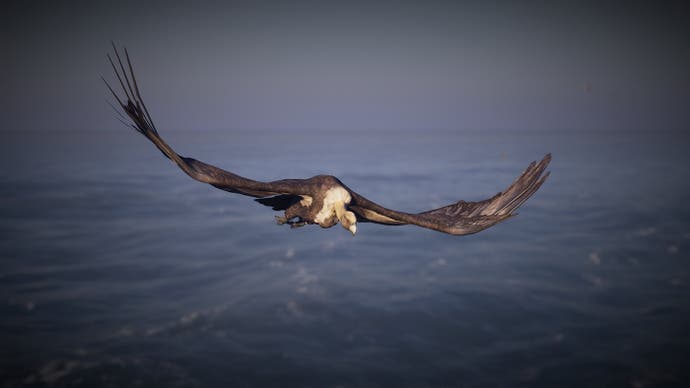On birdwatching in video games
Twitch gaming.
Sit near a yucca plant in Far Cry New Dawn's verdant, strangely pink and only slightly scorched forests and you'll see them: hummingbirds circling the flower spike, chirping away. Get too close and they vanish, the price you pay for crafting a medikit.
The appearance of wild birds in games is increasing as open worlds become more lush and complex. Crows will land on your boat as you explore the Volga in Metro: Exodus, Far Cry's turkeys are famously ornery, like World of WarCraft's Plainstriders, but the king of birdwatching games has to be Assassin's Creed Odyssey (a word Oddworld Inhabitants has forced me to check every time I use it).
Running on a PC in 4K, the amount of detail Ubisoft has managed to squeeze into its world's wildlife is extraordinary. Apart from the occasional extremely low-poly seagull or crow, surely meant to be seen out of the corner of your eye while moving rather than captured in a screenshot and examined, the eagles, ibis and vultures of ancient Greece are all nicely detailed and just right for watching, especially during long sea voyages (as are the whales and dolphins that breach near your ship). I keep meaning to go back to the starting area and work out whether there really are American cardinals, in all their crimson glory, flitting about there. They may be on the wrong continent, the kind of rare accidental migrants that 2,000 years later drag twitchers hundreds of miles to see. Or they may not have been there at all. In some ways that's the beauty of birdwatching: the anticipation, the fear, then the breaking wave of delight as some small brown dot half a mile away comes into focus as something new, previously unseen.

My own experience with hummingbirds is that they do indeed vanish when approached. Driving through Mount Robson Provincial Park in British Columbia, Canada, we stopped at a roadside diner for coffee. Sitting outside in the May sunshine, we could hear a strange sound, as if giant motorised wasps were using the Yellowhead Highway to get to their important wasp business meetings. It soon dawned on us, however, that there were feeders slung from the trees, inviting hummingbirds in for a sip of sugar water, and we could hear the buzzing of their wings as they beat too fast for the eye to follow. Photographing them proved almost impossible, a similar skill to headshotting fast moving enemies in vehicles. Between trying to achieve a fast enough shutter speed to freeze the infinitely fast movement of their wings, and relying on autofocus to track them as they flitted back and forth, I took over 200 frames. Only about ten were remotely sharp. It didn't matter - we were entranced for the half an hour we watched them
The parallels between birdwatching and PC gaming are many. Both involve expensive equipment that's a bit too big to sling easily over your shoulder. Both need patience - as anyone who's tried to download Final Fantasy 15 with its 4K textures from Steam can attest. And unless you've got a fancy living room setup, both mean sitting on something that's less than optimal. The wooden benches present in most bird hides are actually worse than the majority of office chairs. But only just.
It's not just the additional resolution and detail that makes the PC version of Odyssey perfect for birdwatching in, but also its photo mode. Combine this with Ikaros the eagle, who is nicely textured in his own right, if a bit drab and brown, and you have the killer feature: photo mode follows the eagle. It's too perfect - Ikaros doesn't scare up birds sitting on cliffs nearly so much as a human's approach does, meaning you can sneak up on them before entering photo mode and moving the camera even closer.

These attempts to transpose the richness of the natural world into the virtual are representative of games' complexity, and the sheer amount of work that goes into them. Why bother with those hummingbirds? They're not going to attack you or drop crafting materials like the rattlesnakes or turkeys. The yucca plants flash subtly anyway to attract your attention. They're wasting GPU cycles and programmer time. Anyone who's ever noticed flocks of pigeons flying around computer-generated buildings in a movie knows why - they add to the believability of the world, giving a sense of scale that roots the unreal within the real. It's a trick painters have been using for centuries too.
The birds of CG movies are small, and you have no control over the camera. They're merely ornaments, the flock as a symbol of nature. In games you get closer, enough to see the wonky necks and wings. In reality you can get closer still, and meatspace nature is begging for a closer inspection - the details of feathers are almost fractal as they overlay and complement each other. The lively sparkle and keen intelligence in the eye of a bird of prey almost impossible to carry over to another medium.
What reality really needs, then, is a photo mode. The inability of linear time to stop on demand is a major failure of the current spacetime model, begging to be patched in. Once, a tame barn owl landed on top of my camera lens, the perfect setup for a meme-worthy image. My girlfriend at the time completely failed to take a picture of the hilarious scene before it flew away again, despite having a DSLR around her neck and a mobile phone in her pocket. Years later, I married her.








